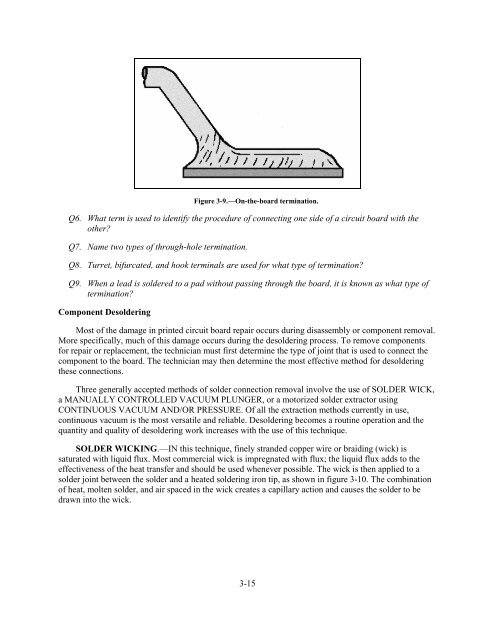Navy Electricity and Electronics Training Series - Historic Naval ...
Navy Electricity and Electronics Training Series - Historic Naval ...
Navy Electricity and Electronics Training Series - Historic Naval ...
Create successful ePaper yourself
Turn your PDF publications into a flip-book with our unique Google optimized e-Paper software.
Figure 3-9.—On-the-board termination.Q6. What term is used to identify the procedure of connecting one side of a circuit board with theother?Q7. Name two types of through-hole termination.Q8. Turret, bifurcated, <strong>and</strong> hook terminals are used for what type of termination?Q9. When a lead is soldered to a pad without passing through the board, it is known as what type oftermination?Component DesolderingMost of the damage in printed circuit board repair occurs during disassembly or component removal.More specifically, much of this damage occurs during the desoldering process. To remove componentsfor repair or replacement, the technician must first determine the type of joint that is used to connect thecomponent to the board. The technician may then determine the most effective method for desolderingthese connections.Three generally accepted methods of solder connection removal involve the use of SOLDER WICK,a MANUALLY CONTROLLED VACUUM PLUNGER, or a motorized solder extractor usingCONTINUOUS VACUUM AND/OR PRESSURE. Of all the extraction methods currently in use,continuous vacuum is the most versatile <strong>and</strong> reliable. Desoldering becomes a routine operation <strong>and</strong> thequantity <strong>and</strong> quality of desoldering work increases with the use of this technique.SOLDER WICKING.—IN this technique, finely str<strong>and</strong>ed copper wire or braiding (wick) issaturated with liquid flux. Most commercial wick is impregnated with flux; the liquid flux adds to theeffectiveness of the heat transfer <strong>and</strong> should be used whenever possible. The wick is then applied to asolder joint between the solder <strong>and</strong> a heated soldering iron tip, as shown in figure 3-10. The combinationof heat, molten solder, <strong>and</strong> air spaced in the wick creates a capillary action <strong>and</strong> causes the solder to bedrawn into the wick.3-15

















